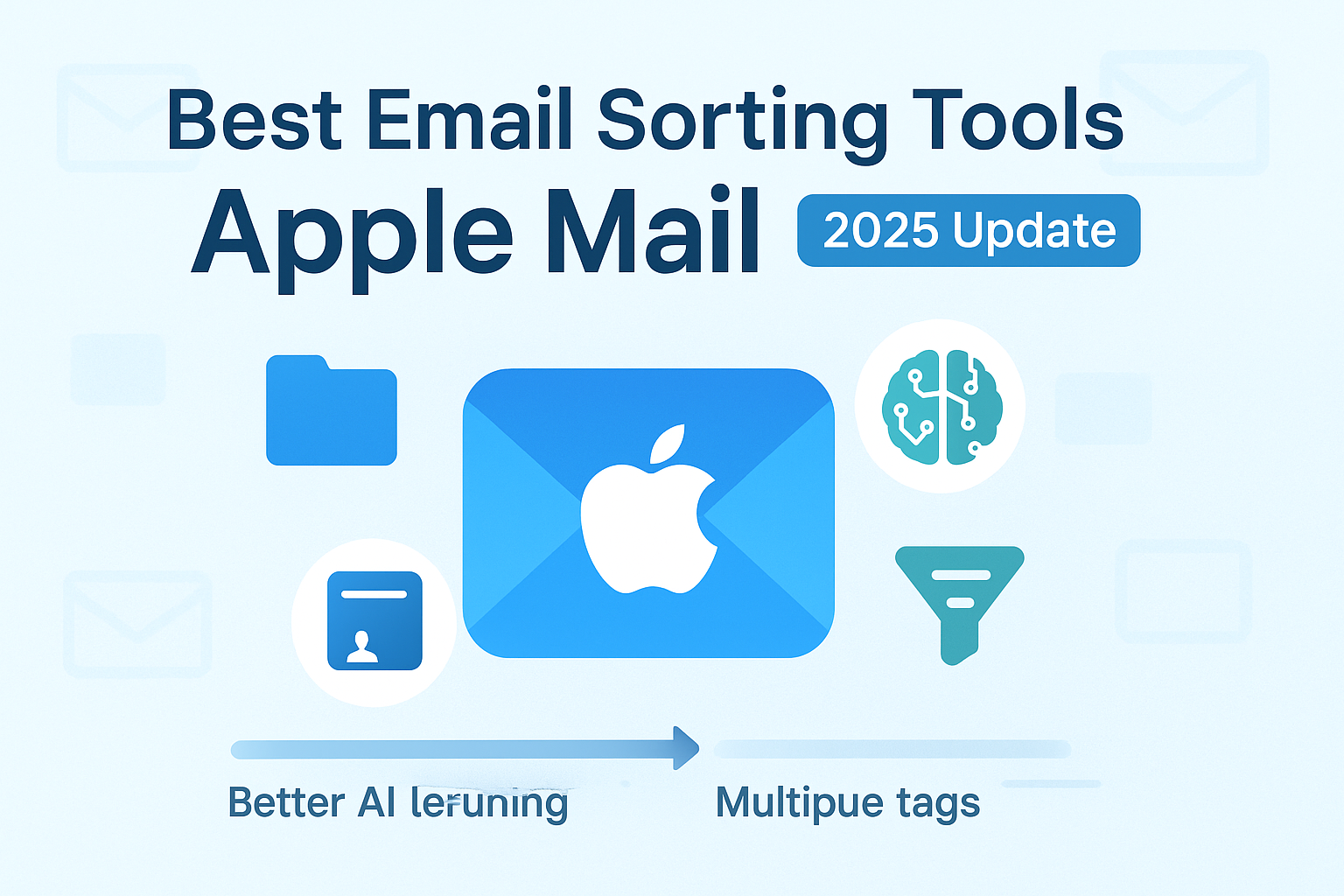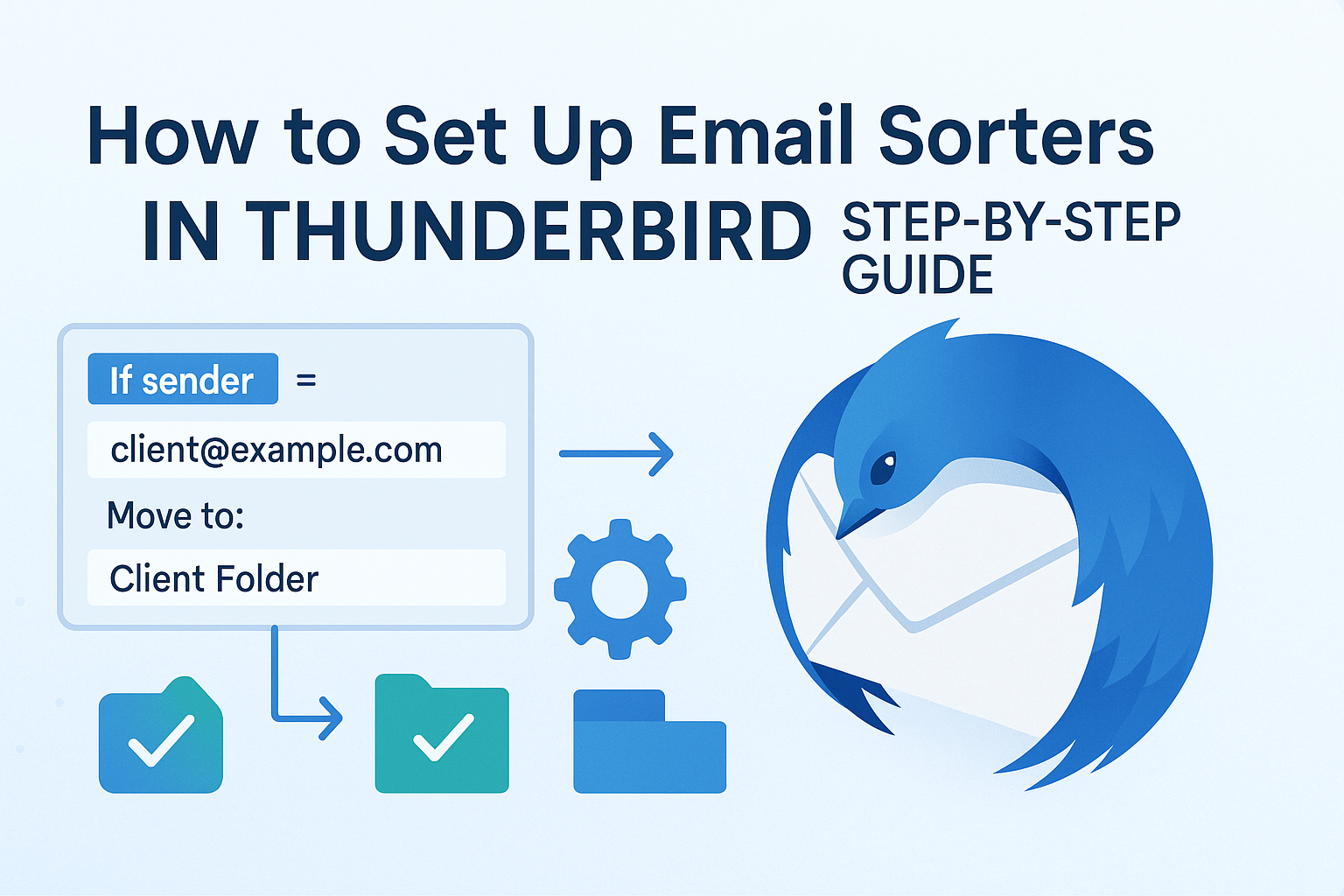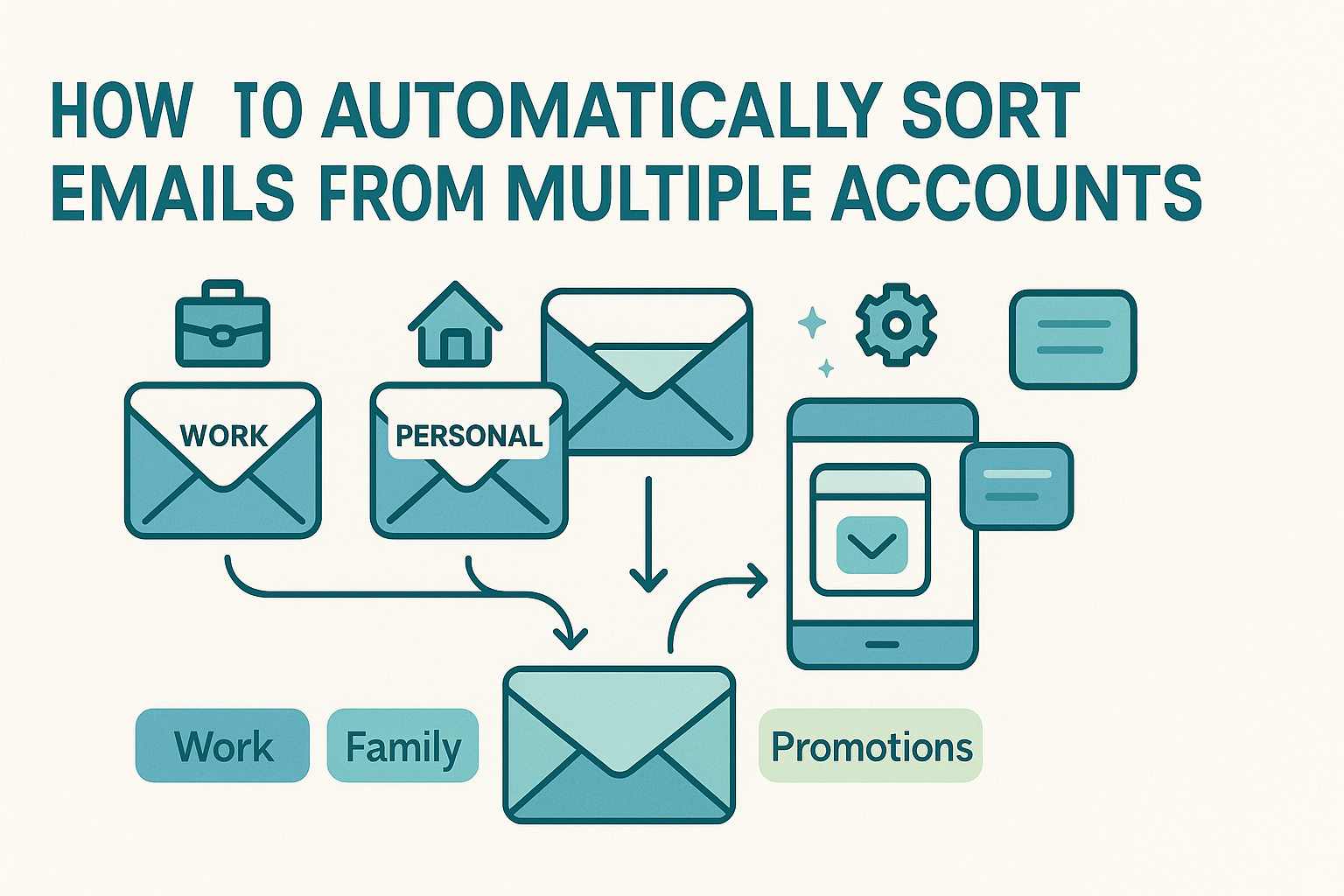Mobile Email Sorter Apps are essential for staying organized on the go. In 2025, most users check and manage emails more often on their smartphones than desktops.
From replying to clients during a commute to clearing out spam while waiting in line, your mobile inbox is now a key productivity tool. But default email apps often lack advanced sorting features.
That’s where dedicated mobile email sorting apps come in. These tools offer smart filters, rule-based automation, auto-categorization, and real-time sync across devices. Whether you’re using Android or iPhone, the right app can move emails to folders, apply tags, mark priority messages, and save you time.
This guide reviews the top mobile email sorter apps for both platforms. We’ll look at each app’s strengths, filtering power, and how well they keep your inbox under control, no matter where you are.
Why Mobile Email Sorter Apps Is Essential Today
Mobile email sorting apps aren’t just useful, they’re essential. In today’s mobile-first world, professionals work from airports, coffee shops, and remote corners of the globe. Whether you’re managing teams across time zones or juggling clients on the go, your phone is often your primary inbox.
But without smart sorting, that inbox quickly becomes a mess, stuffed with unread newsletters, system alerts, and missed client emails.
Mobile email sorters help turn that clutter into control. These apps let you automate your inbox with rules that filter messages in real time. You can:
- Flag invoices from specific senders
- Route internal team threads into a “To Review” folder
- Mute low-priority notifications until after hours
The best part? These sorting rules don’t stay locked to just your phone. Many modern apps sync filters across devices, keeping your inbox organized whether you’re on mobile or desktop. For more on how that works, check out our guide to syncing across platforms.
As email volume keeps growing, mobile sorting isn’t a luxury, it’s a necessity. Whether you receive 50 or 500 messages a day, mobile email sorter apps offer the automation, speed, and clarity that built-in mail apps often miss.
Criteria for Evaluating Mobile Email Sorter Apps
Choosing the right mobile email sorter app depends on how you manage your inbox. Some users need advanced rules for complex workflows. Others just want to cut through clutter and highlight what matters.
Here are the key criteria we used when comparing top apps for Android and iPhone:
Platform Compatibility
All apps in this guide support Android and iOS. Whether you’re on an iPhone or Android phone, your experience should be smooth and consistent across devices.
Email Service Integration
Some apps are built specifically for Gmail, offering precise control over labels and filters. Others support IMAP, iCloud, or are optimized for Apple’s ecosystem. If you’re a Gmail user, check out our Gmail sorter tools. For those using native Apple apps, see our overview of Apple Mail options.
Automation and Custom Rules
The best apps let you create custom filters based on sender, subject, keywords, time, or message behavior. These go beyond simple swipes or preset folders, giving you full control over how your inbox behaves.
User Experience & Notification Control
We prioritized apps with clean interfaces, quick load times, and reliable performance. Smart notification management and triage features help you respond faster, without getting overwhelmed by pings.
Pricing & Value
Some apps charge a premium, but others offer powerful features for free. If you’re looking to save, browse our top picks in the free sorters list for budget-friendly options.
Spark
Spark has emerged as a favorite for mobile users who crave smart prioritization without the noise. Available on both Android and iOS, Spark uses an intelligent Smart Inbox that separates important messages—like personal emails and team communications, from low-priority ones such as newsletters or flash sales. This auto-sorting system learns from how you interact with messages, promoting meaningful conversations while demoting less urgent content.
One of Spark’s standout features is its collaborative capabilities. Teams can create shared templates, assign emails to colleagues, and comment on drafts in real time, functionality that rivals many desktop email clients. Even on mobile, you can implement rule-like actions: flagging, snoozing, or moving emails based on sender or subject. The app also integrates with other email services you might use, including Gmail and Outlook, making it a consistent choice across platforms.
Spark’s design aligns with the expectations of Apple users, clean, polished, and intuitive—while still delivering the power Android users expect. Push notifications are customizable, and automatically grouped email threads reduce clutter. Spark offers a free tier that supports most individual workflow needs, with premium plans for teams requiring more advanced collaboration. If you’re looking for an email tool that feels familiar yet smart, Spark delivers both strong mobile automation and a buffer-free reading experience.
Gmail App (Official App + Extensions)
While the Gmail app for Android and iOS may seem simple compared to dedicated sorting tools, it remains a cornerstone for many due to its reliable bundle categorization and integration with Gmail’s desktop filters. The app intelligently organizes messages into categories like Social, Promotions, and Updates, helping keep your primary inbox focused on urgent or personal communications. You can also apply swipe gestures to archive, delete, or mark messages as important with a few taps.
One of the app’s biggest strengths is its seamless compatibility with Gmail sorters you set up at the desktop level. Complex filters based on sender, keywords, or size apply automatically on mobile. You can also use extended functionality like in-app delegation and smart reply suggestions to manage messages quickly.
While Gmail’s mobile rule-building is limited, the deep syncing and reliable bundling make it a solid choice for users already embedded in Google’s ecosystem. If you’re looking for more control, third-party apps can complement Gmail with advanced rule creation, but for many, the official Gmail app offers enough automation, especially when it’s already configured at the account level.
Edison Mail
Edison Mail stands out with its AI-powered assistant designed to simplify mobile inbox management on both Android and iOS. Upon setup, the app automatically categorizes emails, everything from shipping updates to travel itineraries and subscription notifications is grouped neatly without user input. The assistant also identifies recurring subscriptions and payment reminders, offering the ability to unsubscribe directly or snooze emails until later.
A significant advantage of Edison Mail is its multilayered notification control. Users can customize alerts by category, mute newsletters, or highlight transaction emails for immediate attention. The app’s transaction-centric sorting is particularly valuable for users who rely on timely updates from financial services. And best of all, Edison Mail is completely free, offering powerful sorting capabilities without a price tag, making it one of the most compelling options among free sorters for users who want robust features at no cost.
Airmail
Airmail caters particularly to users who prefer a refined experience similar to Apple’s ecosystem. Designed with elegance and efficiency in mind, it works seamlessly across both macOS and iOS, and offers a functional Android client as well. On mobile, Airmail excels at letting users create detailed filters, sorting based on sender, subject line terms, or even custom folder destinations. These filters sync across devices, offering consistent behavior whether you check mail on desktop or phone.
In addition to filtering, Airmail provides custom swipe actions, snooze options, and integration with calendar and task apps. This makes it ideal for professionals who need granular control over sorting and follow-up processes. If you often find yourself organizing email by project phase, urgency, or client, Airmail brings rule creation and detailed email controls into a coherent, Apple-friendly interface. It’s especially attractive for users already using Apple Mail, as it complements that experience and enhances multi-device coherence, including Apple Mail users who want more sorting power.
Polymail / Newton Mail
Polymail and Newton Mail both offer premium email sorting and productivity tools designed for professionals and cloud-centric teams. These apps use smart sender recognition, read receipts, scheduled follow-ups, and advanced search features, all wrapped in a clean, streamlined mobile interface.
Polymail focuses on team collaboration, allowing inbox workflows to adapt dynamically as colleagues respond or assign threads. Newton Mail uses its “Tidy Inbox” feature to sort low-priority email into a designated section. Both operate via cloud-based syncing, making them ideal cloud-based sorters for mobile-first professionals. However, these premium features come with subscription costs and may not be necessary for users with simpler sorting needs.
Cross-App Feature Comparison and Use Scenarios
On the move, your focus might be on triaging quickly. Those pushing messages into folders will appreciate Spark’s Smart Inbox or Edison’s categories. Users in structured workflows may prefer Airmail or Polymail/Newton Mail for their rule-based precision and cross-device consistency. And if cost is a concern, Edison Mail and Spark’s free tiers offer a strong foundation without subscription fees.
All apps discussed support cloud syncing to some extent, though setups vary in friction and coverage. For a more detailed breakdown of how sorting logic flows across devices, especially between mobile and desktop platforms. That way, whether you’re handling email during a commute or wrapping up a task on your desktop, your sorting rules stay in sync.
Budget and Free Alternatives
For those who are budget-wise, Edison Mail and Spark’s free versions are solid starting points. They include essential sorting features like auto-categorization, snoozing, and notification management. If you’re evaluating multiple no-cost alternatives or comparing free tiers among top apps, our free sorters article provides a comprehensive overview of available options—helping you find the best fit without spending a dime.
Choosing the Right App for Your Workflow
Your ideal mobile email sorter depends on your priorities. If prioritization and collaboration matter most, Spark or Polymail might be right. If you want light automation with exceptional value, Edison Mail stands out. For Apple enthusiasts or power users wanting granular control, Airmail offers precision and shine. And for team-centric or cloud-intensive workflows, Newton Mail or Polymail provide premium features. Match your choice to your workflow needs, considering whether you need robust rule engines, subscription-based features, or simplicity.
Conclusion
In 2025, mobile email sorting isn’t a luxury, it’s essential for staying productive. These five apps each bring unique strengths to the table: whether it’s Spark’s Smart Inbox, Edison Mail’s transactional filters, Airmail’s Apple-style customization, or the premium capabilities of Newton Mail and Polymail. By choosing a tool that aligns with your priorities, be it automation, cross-platform syncing, ease of use, or cost, you can transform your mobile inbox into a smart, efficient workspace.
Frequently Asked Questions
What’s the best free mobile email sorter?
Edison Mail and Spark offer strong free tiers with intelligent sorting, clean interfaces, and no paywall for basic automation.
Can I sync mobile sorting rules to desktop?
Yes, many of these apps sync rules server-side to your web or desktop inbox. Visit our sync across devices guide for detailed instructions.
Are subscription apps worth the cost?
For team communication, advanced filtering, and workflow management, apps like Polymail/Newton Mail may justify their premium features, but simpler workflows often thrive with free or freemium tools.
Do these apps work with both Gmail and iCloud?
Most support IMAP and major providers. Gmail users benefit from deep label integration highlighted in Gmail sorters, while Apple Mail users gain from consistent syncing and UI integration.
How do I switch between mobile email sorters?
Start by exporting your settings when possible, then update client-side rules and permissions. Legacy data may move differently depending on provider. Experiment and choose what feels consistent and reliable.




